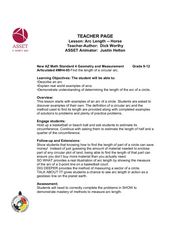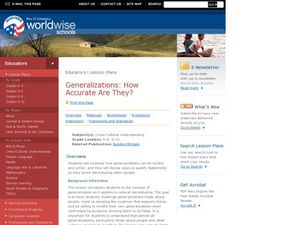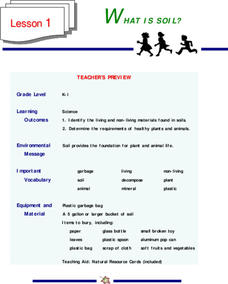Curated OER
A Handy Measure
How many hands tall are you? Challenge kids to measure themselves the way the 19th century Oklahoma horse traders measured their prize horses (can they guess how many hands tall a horse had to be?). There's some background information...
Curated OER
The Learning Network: Poetry Pairing July, 21, 2011
Although not a complete lesson plan, this set of emotionally powerful texts could be used in a variety of lessons. From The New York Times' Learning Network site, the resource includes a poem, an excerpt from a New York Times article and...
Curated OER
Animals: Horses
Students use the internet to examine the different types of horse breeds, and how to properly groom and feed a horse. They participate in online games and color pages.
Curated OER
No Foot, No Horse
Why do horses wear shoes? Why do people wear shoes? Using worksheets, which are embedded in the plan, learners write descriptive paragraphs about their own shoes, classify a pile of shoes, and also engage in math games about the variety...
Balanced Assessment
Don't Fence Me In
Investigate the complexities of design problems using geometric concepts. The task asks scholars to design a fence for a horse based on the distance it can travel within one hour. It is a seemingly simple task — until individuals learn...
PBS
Scale City — Proportional Relationships in the Real World
Strive to determine your stride. Scholars first view an informative video on the Kentucky Horse Park and the 28-feet stride of the Man o' War. They then work together in groups to find the length of their own strides by using the number...
Curated OER
Arc Length - Horse
High schoolers define an arc and calculate its length. In this geometry lesson, students find examples of arc in the real world. They show their understanding of arcs through problem solving.
Curated OER
Down, Dung and Dirty
Students observe the changes seen in succession and the biodiversity of a community through its species richness and evenness. They create a dung culture in a clear plastic cup from horse, goat or cow dung then observe the numbers of...
Curated OER
Million Dollar House
Fourth graders use a combination of calculators and spread sheet software to furnish their own million dollar horse without going over the specified amount of a million. The goal being to create a house that came to the exact amount of...
Curated OER
What Do We Learn From Fossils?
Students investigate what a fossil is and how it came to be. In this fossil lesson, students examine pictures of skeletons and identify characteristics that can and cannot be determined by a fossil. Students complete diagrams of a...
Curated OER
Paint's Family Tree
Fifth graders learn about hereditary traits and family trees. In this heredity lesson, 5th graders act out a family tree skit and complete a 'trait summary' worksheet. Students then complete the 'Paint's Family Tree' worksheet. Students...
Curated OER
Plains Indians
First graders create a KWL chart on Native Americans and listen to a speaker from a local Indian Reservation. As a class, they are read part of a Native American story in which they pick their own Native American name and identify their...
Curated OER
Down, Dung and Dirty
Students investigate the stages of succession in animal dung communities. They create a dung culture using fresh cow, goat or horse dung then record data on the fungal species that appear over a two week period.
Curated OER
Animal Movements
Students evaluate biology by identifying animal anatomy. In this animal characteristic lesson, students examine pictures of horses, rabbits, bees and other animals while discussing their method of transportation. Students listen to an...
Oklahoma State University
A Hundred Bales of Hay
This lesson combines math, visual arts, and language arts activities that all focus on the making, and baling of hay. The activities can be adjusted to address different age ranges. Most of the activities focus on gaining...
Ocean Explorer
Looking for Clues
Upper graders become "shipwreck detectives" by studying the debris field from a shipwreck in the Aegean Sea which took place in the 700s. A website is accessed that gives specific information about the debris field, and pairs of...
Curated OER
Mapping the Aegean Seafloor
Earth science learners create a two-dimensional topographic map of the floor of the Aegean Sea. They use it to then create a three-dimensional model of the ocean floor features. This comprehensive resource delivers strong background...
Curated OER
Where Are the Dinosaurs?
Students recognize that they haven't seen a dinosaur because they no longer exist. In this dinosaur lesson, students view videos and understand what the dinosaur habitat was like. Students role play dinosaurs. Students explore dinosaur...
Curated OER
Generalizations: How Accurate Are they?
Work together to evaluate the accuracy of generalizations. Examine the effects of cultural stereotyping based on generalizations. Students will engage in a class discussion aimed at answering the question, "What are some ways we can...
Curated OER
The Roving Robotic Chemist
Junior oceanographers and underwater geologists describe the four major steps of mass spectrometry. They compete in small groups to simulate the tracking of a deepwater methane plume using imaginary autonomous underwater vehicles. Give...
Curated OER
Lessons for Young Children with Autism
Here are a variety of lessons geared for young children with Autism. There are 12 short activities intended to build attention, imitation, communication, independent living, social, motor, and literacy skills. Each skill is geared toward...
Curated OER
Dirt Babies
Dirt babies are an excellent way to show young botanists the plant life cycle. They explore the functions and industry behind grasses before growing some of their own. Use the informational text here and consider implementing some...
Curated OER
What is Soil?
Students study living and non-living materials that are found in soil. They study the things required by plants and animals to remain healthy. They design a collage of sand, stones, leaves and other natural items.
Curated OER
Where Am I?
Extensive background on marine navigation is provided for you as the teacher. Assign groups to research marine navigation techniques and construct astrolabes. Resource links are listed for extension ideas. If you are teaching an...
Other popular searches
- Crazy Horse
- Black Cowboy Wild Horses
- Horses Body Parts
- Horseshoe Crabs
- Wild Horses
- Sea Horses
- Wild Horses Sheet Music
- Facts About Horseshoe Crabs
- Horse Racing
- Horse Races
- Horse Movement Activities
- Horse Behavior

























